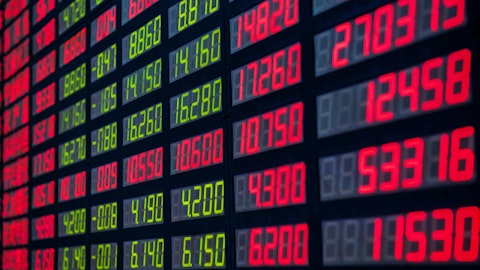At Insider Monkey, we pore over the filings of more than 700 top investment firms every quarter, a process we have now completed for the latest reporting period. The data we’ve gathered as a result gives us access to a wealth of collective knowledge based on these firms’ portfolio holdings as of September 30. In this article, we will use that wealth of knowledge to determine whether or not JPMorgan Chase & Co. (NYSE:JPM) makes for a good investment right now.
JPMorgan Chase & Co. (NYSE:JPM) shares haven’t seen a lot of action during the fourth quarter and the hedge fund sentiment was unchanged at the end of 2015. The stock was in 100 hedge funds’ portfolios at the end of December. The level and the change in hedge fund popularity aren’t the only variables you need to analyze to decipher hedge funds’ perspectives. A stock may witness a boost or drop in popularity, but it may still be less popular than similarly priced stocks. That’s why at the end of this article we will examine companies such as China Mobile Ltd. (ADR) (NYSE:CHL), The Procter & Gamble Company (NYSE:PG), and AT&T Inc. (NYSE:T) to gather more data points.
JPMorgan’s stock has declined by 3.39% in the last 52 weeks amid a broader market sell-off, weak oil prices and investors’ concerns about the slowdown of economic growth around the world, which might affect the Fed’s decision to raise interest rates. Nevertheless, the stock of the US’ largest bank has performed much better than its peers and its management is optimistic about the future. In fact, last month, JPMorgan’s CEO Jamie Dimon purchased around $26.6 million worth of the bank’s shares, which represents a very bullish signal for investors watching insider trading.
For the last year, JPMorgan posted a record net income of $24.4 billion, which was up by 12% on the year. At the investor day that was held by the bank last month, JPMorgan said that it might have to increase reserves for energy loans by $1.5 billion if oil prices stay around the $25 level for more than 18 months. The total of $1.65 billion that JPMorgan plans to reserve for energy loans is higher than it had been anticipated. At the same time, JPMorgan said that it still plans to reach $30 billion in net income by 2019 and CEO Dimon said that he is still bullish on the US economy, having added that households are benefitting greatly from the lower gasoline prices to increase their spending in other categories.
Follow Jpmorgan Chase & Co (NYSE:JPM)
Follow Jpmorgan Chase & Co (NYSE:JPM)
Receive real-time insider trading and news alerts
If you’d ask most market participants, hedge funds are seen as worthless, old investment tools of the past. While there are more than 8000 funds with their doors open at the moment, Our experts look at the leaders of this group, around 700 funds. These investment experts administer the lion’s share of the hedge fund industry’s total capital, and by following their inimitable picks, Insider Monkey has unsheathed various investment strategies that have historically outrun the S&P 500 index. Insider Monkey’s small-cap hedge fund strategy exceeded the S&P 500 index by 12 percentage points a year for a decade in their back tests.
Now, we’re going to take a look at the key action encompassing JPMorgan Chase & Co. (NYSE:JPM).
Hedge fund activity in JPMorgan Chase & Co. (NYSE:JPM)
Heading into 2016, a total of 100 of the hedge funds tracked by Insider Monkey held long positions in this stock, a change of 0% from the previous quarter. With the smart money’s sentiment swirling, there exists an “upper tier” of notable hedge fund managers who were boosting their holdings considerably (or already accumulated large positions).
According to publicly available hedge fund and institutional investor holdings data compiled by Insider Monkey, Lansdowne Partners, managed by Alex Snow, holds the largest position in JPMorgan Chase & Co. (NYSE:JPM). Lansdowne Partners has a $1.33 billion position in the stock, comprising 9.1% of its 13F portfolio. The second largest stake is held by Ken Fisher’s Fisher Asset Management, with a $923.7 million position; the fund has 1.8% of its 13F portfolio invested in the stock. Other professional money managers with similar optimism include Boykin Curry’s Eagle Capital Management, Edgar Wachenheim’s Greenhaven Associates and Richard S. Pzena’s Pzena Investment Management.
On the following page, we are going to take a look at some funds that unloaded their entire stakes in JPMorgan, as well as investors that added the stock to their 13F portfolios. In addition, we will compare the hedge fund activity surrounding other stocks similar to JPM.
Because JPMorgan Chase & Co. (NYSE:JPM) has faced falling interest from hedge fund managers, we can see that there lies a certain “tier” of funds who sold off their entire stakes in the third quarter. At the top of the heap, Daniel S. Och’s OZ Management dropped the largest stake of the 700 funds watched by Insider Monkey, totaling about $284.4 million in stock. On the other hand, Adam Peterson’s Magnolia Capital Fund initiated a stake worth $8.50 million at the end of 2015.
Let’s now review hedge fund activity in other stocks similar to JPMorgan Chase & Co. (NYSE:JPM). These stocks are China Mobile Ltd. (ADR) (NYSE:CHL), The Procter & Gamble Company (NYSE:PG), AT&T Inc. (NYSE:T), and Toyota Motor Corporation (ADR) (NYSE:TM). All of these stocks’ market caps match JPM’s market cap.
| Ticker | No of HFs with positions | Total Value of HF Positions (x1000) | Change in HF Position |
|---|---|---|---|
| CHL | 24 | 256853 | 4 |
| PG | 52 | 8994349 | -6 |
| T | 48 | 3097219 | -12 |
| TM | 13 | 230404 | 0 |
As you can see these stocks had an average of 34 hedge funds with bullish positions and the average amount invested in these stocks was $3.15 billion. That figure was $7.58 billion in JPM’s case. The Procter & Gamble Company (NYSE:PG) is the most popular stock in this table, while Toyota Motor Corporation (ADR) (NYSE:TM) is the least popular one with only 13 hedge funds holding long positions. Compared to these stocks JPMorgan Chase & Co. (NYSE:JPM) is more popular among hedge funds. Considering that hedge funds are fond of this stock in relation to its market cap peers, it may be a good idea to analyze it in detail and potentially include it in your portfolio.





